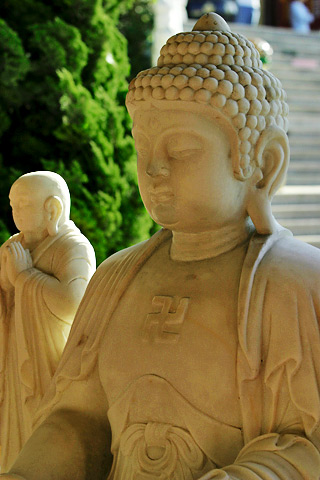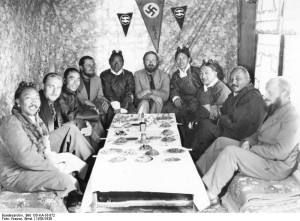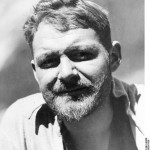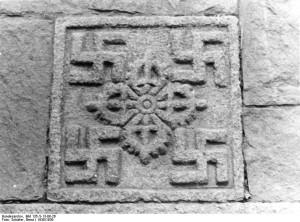 Sometimes even the very best researchers can’t resist the temptation to be a little cheesy, a little celluloid even, unleashing their inner publicity hounds for a short romp. For how else can one explain the more bizarre titles that occasionally adorn the top of scientific papers: “Acute Conjunctival Inflammation Following Contact with Squashed Spider Remains,” for example, or “The Effect of Country Music on Suicide.”
Sometimes even the very best researchers can’t resist the temptation to be a little cheesy, a little celluloid even, unleashing their inner publicity hounds for a short romp. For how else can one explain the more bizarre titles that occasionally adorn the top of scientific papers: “Acute Conjunctival Inflammation Following Contact with Squashed Spider Remains,” for example, or “The Effect of Country Music on Suicide.”
More often than not, such titles are merely playful window-dressing to lure overworked colleagues into picking up said paper and paying attention. And perhaps that’s what first crossed the minds of the readers of Meteoritics & Planetary Science, when their eyes fell on a title in the September issue: “Buddha from Space—An Ancient Object of Art made of a Chinga iron meteorite fragment.”
But principal author Elmar Buchner, a geologist at the University of Stuttgart, and the members of his scientific team were not joking.  Indeed, they were being quite serious about a strange artifact made from a rare extraterrestrial material, and about its role in a disturbing chapter in German science. And not only did the team snag the attention of astronomers and meteorite experts, but they also soon attracted the notice of a prominent and very puzzled archaeologist.
Indeed, they were being quite serious about a strange artifact made from a rare extraterrestrial material, and about its role in a disturbing chapter in German science. And not only did the team snag the attention of astronomers and meteorite experts, but they also soon attracted the notice of a prominent and very puzzled archaeologist.
But first, some basics. The objet d’art in the paper’s title is a small, delicately chiselled sculpture of what appears to be the Buddhist god Vaisravana. The figurine of this god wears a cuirass ornamented with a swastika, a sun symbol that crops up quite often on Buddhist and Hindu statues. The statue stands just ten inches tall, but it is much heavier and denser than it looks. Indeed, it weighs 23 pounds. If you want to see a photo of it, click here and open the pdf to page 1496.
In 2007, the statue’s anonymous owner contacted the scientific team to determine what it was made from. Unable to give an easy answer, Buchner and his team took several tiny samples and conducted both geochemical and mineralogical analyses. They found that it was made from meteoritic iron. Moreover, its element values exactly matched those in the Chinga meteorite which fell to earth an estimated 10,000 to 20,000 years ago in the border district between Siberia and Mongolia.
Buchner and his team could not provide any detailed information on the provenience of the statue, which they called the “iron man. They simply reported what they had been told:
“To our knowledge, the statue was brought to Germany by a Tibet expedition in the years 1938-1939 guided by Ernst Schaefer (zoologist and ethnologist) by order of the German National Socialist government. The aim of this expedition was to find the roots of the Aryan religion and the Aryan origin.”
But the statue looked rather odd to those who studied ancient Buddhism. Deeply puzzled, an archaeologist friend emailed his immense network of contacts, asking them for their thoughts. In short order, they weighed in, stirring up an animated debate. Was the statue a modern fake, wondered some, or something truly old? And did it have anything to do with a German expedition dispatched to Tibet in 1938 by the Nazi government of the day?
And now I want to fully disclose my interest in this. Between 2001 and 2005, I obtained and studied at length the original archival documents from the 1938-39 expedition that Ernst Schaefer led to Tibet, and I eventually wrote about this expedition in a heavily footnoted book entitled The Master Plan. So I waded head first into the debate.
 To make a long story short, I think Ernst Schaefer and his colleagues did indeed collect this statue. Schaefer was an early member of the SS. He relished exploration and foreign adventure, and in 1935, he took part in an expedition to remote lands along China-Tibet border. There he dug several ancient graves containing human skeletons, and found what he claimed were urns and other burial goods ornamented with “old Aryan symbols.” In addition, he encountered local nobles and landowners—members of the upper class—who possessed what he called “pure Aryan facial characteristics, strong hook noses, red-black hair and almost gray-blue eyes.” Schaefer, the SS-man and Nazi, was fascinated. “This opens up a whole new area of science in a productive and appreciative field –to establish how far the Aryan race interspersed on the Roof of the World,” he wrote.
To make a long story short, I think Ernst Schaefer and his colleagues did indeed collect this statue. Schaefer was an early member of the SS. He relished exploration and foreign adventure, and in 1935, he took part in an expedition to remote lands along China-Tibet border. There he dug several ancient graves containing human skeletons, and found what he claimed were urns and other burial goods ornamented with “old Aryan symbols.” In addition, he encountered local nobles and landowners—members of the upper class—who possessed what he called “pure Aryan facial characteristics, strong hook noses, red-black hair and almost gray-blue eyes.” Schaefer, the SS-man and Nazi, was fascinated. “This opens up a whole new area of science in a productive and appreciative field –to establish how far the Aryan race interspersed on the Roof of the World,” he wrote.
Of course, there was no Aryan master race that had once conquered and lorded it over Asia. But Schaefer thought there was, and on his return to Germany he met personally with Heinrich Himmler, the head of the SS, to discuss the journey and his findings. Himmler, something of an amateur archaeologist, was delighted, so delighted in fact that he put Schaefer in charge of a major new expedition to Tibet and to Mongolia in 1938. The mission was to look for further evidence of Aryan overlords in the Himalayas.
 Did Schaefer collect the “iron man” statue during this 1938 expedition as a prime exhibit? Surviving archival documents reveal that he and his team collected several statues of Buddha, and that Schaefer himself displayed two of these statues, one large, the other small, in his office in Munich in 1942. Other archival evidence, such as the photograph that Schaefer took personally of swastikas carved on a building in Lhasa (above), reveal his fervent desire to bring back more evidence of “old Aryan symbols.”
Did Schaefer collect the “iron man” statue during this 1938 expedition as a prime exhibit? Surviving archival documents reveal that he and his team collected several statues of Buddha, and that Schaefer himself displayed two of these statues, one large, the other small, in his office in Munich in 1942. Other archival evidence, such as the photograph that Schaefer took personally of swastikas carved on a building in Lhasa (above), reveal his fervent desire to bring back more evidence of “old Aryan symbols.”
When Schaefer returned to Germany on August 4, 1939, Himmler waited on the runway in Munich to personally welcome and congratulate him. In the days that followed, Schaefer received an invitation to lecture on his findings to senior Nazi officials: Adolf Hitler himself gave notice that he would attend. But circumstances seem to have intervened. On September 1st, the German army invaded Poland, and by then Hitler had far more serious matters on his mind.
But what of the iron man? Had Schaefer collected an image of Buddhist god holding a swastika as evidence of an ancient master race in Asia? I think it is very likely.
Photos: A statue of Buddha with the ancient sun symbol, courtesy Aaron Logan; The Schaefer expedition members meeting Tibetan officials, courtesy Bundesarchiv, Germany Bild 135-KA-10-080; Ernst Schaefer, courtesy Bundesarchiv, Germany Bild 135-KB-14-089; Photo of swastika decoration on building in Lhasa taken by Ernst Schaefer, Bundesarchive, Germany, Bild 135-S-13-08-26 .
Heather, this is fascinating. Now I’m spooked.
great story.
Thanks, Barb! Much appreciated.